It may seem like the sky is a single part of any landscape, however the sky is actually connected to the rest of the painting…
The Sky’s the Limit: How to Paint a Simple but Realistic Watercolor Sky

As soon as you learn how to paint skies, you will be able to set any mood of your landscape or seascape painting through a clear, sunny sky or a stormy night. The sky can play a supporting role or be the major star of a composition. Changing continuously, it has endless variety in appearances.
Follow along and learn how to paint the sky with clouds.
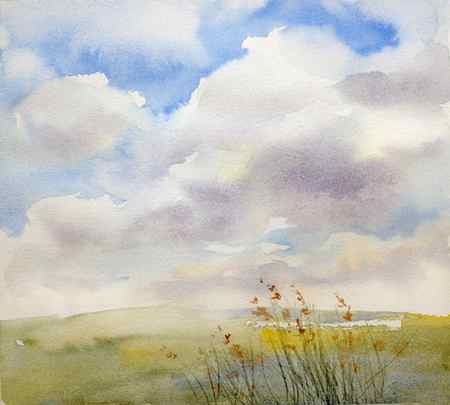
Tips for painting the sky
- Vary the color of the sky. Use red and yellow along with blue, balancing warm and cool colors.
- When painting the sky with clouds wet-in-wet, remember that colors will lighten up as the paper dries.
- Note that the sky appears warmer and lighter as it approaches the horizon.
- Clouds, like any other 3-D objects, comply with the rules of perspective and have lighter and darker areas, depending on the sunlight.
- Clouds will look more lively and luminous if you balance hard and soft edges.
- I recommend that you hold your paper at about 30-degree angle.
Materials
For this painting, I used a medium-sized round brush and three colors: cobalt blue, Naples yellow and cadmium red.
Get My FREE Guide »
Step 1:
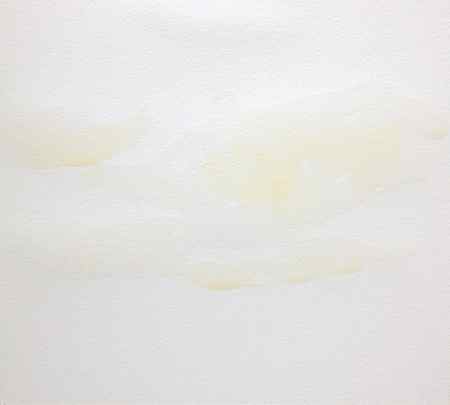
Wet the paper and wait until the water is absorbed a little bit. When the surface is still damp but no longer glossy, you’ll have more control over the painting process.
Apply a few big, watery brushstrokes of Naples yellow, defining the position of the clouds. It might be easier to do a preliminary contour drawing, but I felt like improvising. If you want to sketch the clouds first, make sure to keep the lines very light.
Tip: Use a watercolor pencil to make a subtle preliminary sketch of the clouds, so the lines disappear as you paint.
Step 2:
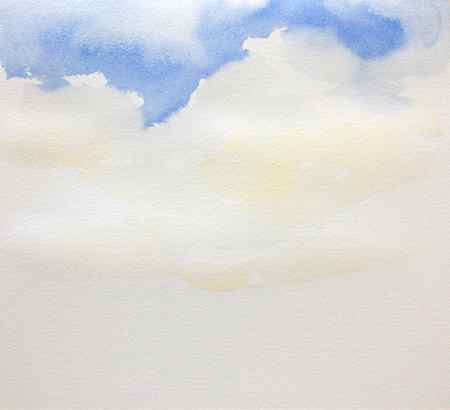
Load the brush with a large amount of liquid cobalt blue and start painting the top edge of the clouds. In order to keep the brushstrokes effortless and spontaneous, use the flat side of the brush rather than the tip.
By this time, my paper was almost dry on top, so the edges came out sharp. I gently softened some of them with a damp brush, leaving some hard edges here and there.
Step 3:
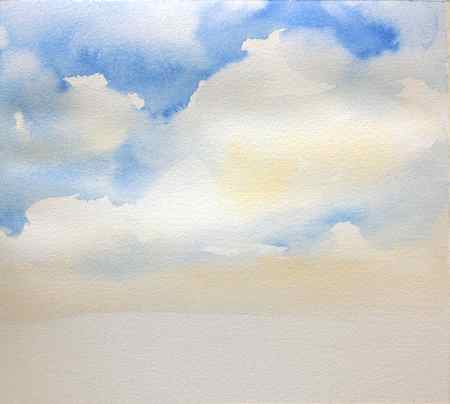
Continue to paint the blue sky, defining the undersides of the clouds, along with some distant clouds and the horizon line.
Step 4:
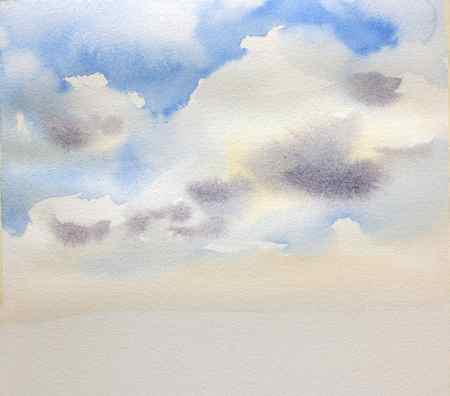
Now that the paper is still wet in the clouds area, it’s time to paint some shadows. Add a few light brushstrokes, using a mixture of cobalt blue and cadmium red.
Step 5:
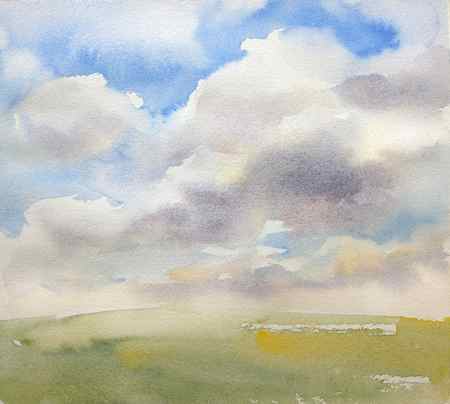
Keep on adding shadows and softening edges with the flat side of your brush. I also painted the ground with quick, large brushstrokes, using the mixture of cobalt blue and Naples yellow.
Step 6:
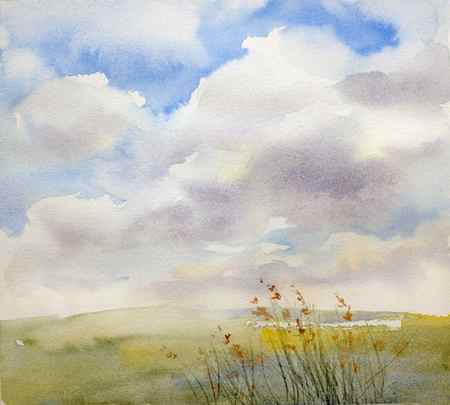
When the sky was done, I added some details on the foreground to give the painting a finished look.
More watercolor sky examples
Here’s another example of clouds I painted using the same approach — except this time, I used ultramarine blue, alizarin crimson and Naples yellow for the sky.
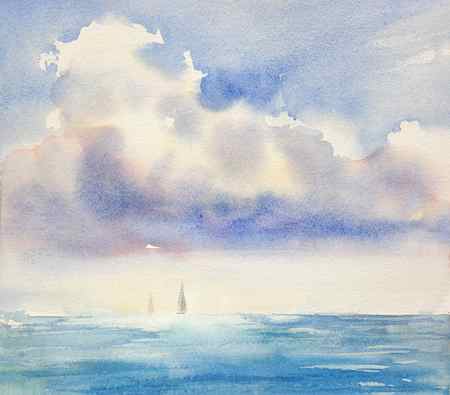
While the above two paintings express calm and peaceful moods, the following illustrates a completely different atmosphere. Turning away from blue skies and puffy clouds, I came up with with an image of turbulent and stormy sky. Combining rich, intense darks with strong value contrasts adds greatly to the drama in this watercolor.
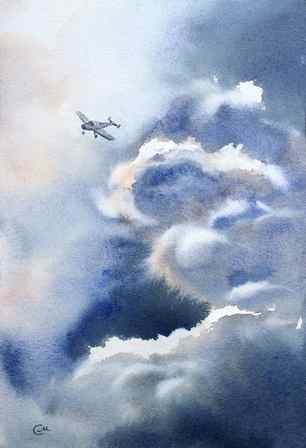
Get My FREE Guide »
Make a comment
5 Responses to “The Sky’s the Limit: How to Paint a Simple but Realistic Watercolor Sky”
- TERESA February 17th, 2022 This is perfect for what I want to start achieving. Skies are a favorite subject of mine. Thanks. Reply
- tony February 15th, 2022 Like your step by step painting. Will try myself. Reply
- Janette September 18th, 2021 What size paper and brush(es)? Lovely technique. Reply
- laurence kalnin August 26th, 2021 I have your beautiful painting, “Madchen mit Lutscher” in Sydney, please advise email, I will send photo Reply
- Tova October 11th, 2020 thank you on your explaining it’s makeme with insparation to try this now Reply
Backruns
Backruns are a great way to add texture to your sky’s! They do not always produce the same results and thats what makes them exciting. Backruns are caused by adding clear water onto the paper while the paint is still damp. This causes the pigment on the paper to move to the edges of the water drop. Read more about them here.

Lighten the sky towards the horizon
Ever wonder how you can use the sky to add depth and dimension to your painting?
If you go outside and look at the sky you’re most likely going to notice the colors gradually becoming lighter towards the horizon. This means painting your sky’s with a lighter value towards the horizon will provide your painting with a sense of depth and distance.
Moreover with the sky lighter towards the horizon the viewer can differentiate between the lanscape and the sky. This makes the lanscape elements more visible.
For instance, in the painting below you can see the sky is lighter at the horizon making the top of the trees appear brighter.

Preserve the white
Preserving that white is a key factor when incorporating an eye-catching sky in your landscape. Watercolors tend to have a transparent characteristic, this means that the light can pass through the pigment and reflect back. This causes the pigments to appear bright and vibrant .
With this in mind it’s important not to do to much to the sky, lay the pigments, let them dry and paper do the rest.
Take the painting below for example, I have done very little to the sky and so the paint is still transparent. This resulted in a warm sunrise scenery.






